Все способы:
- Вариант 1: Установка приоритетов
- Способ 1: Получение прав администратора
- Способ 2: Отключение UAC
- Способ 3: «Безопасный режим»
- Вариант 2: Завершение процесса
- Способ 1: «Командная строка»
- Способ 2: Сторонние утилиты
- Способ 3: Проверка на вирусы
- Вопросы и ответы: 0
Вариант 1: Установка приоритетов
Нередко пользователи сталкиваются с данной проблемой при попытке установить приоритеты для определенной программы или игры, используя функции «Диспетчера задач». Это актуально в условиях, когда надо, чтобы система выделяла как можно больше ресурсов для того или иного процесса.
Иногда при выставлении приоритетов процессов в «Диспетчере задач» отображается системное окно с предупреждением, свидетельствующим об отказе в доступе. Если такое происходит не в первый раз и сразу с несколькими процессами, то здесь есть повод для беспокойства. Для начала выполните обычную перезагрузку Windows 10, но если она не принесла результата, то может потребоваться устранение неполадки вручную. О методах мы поговорим ниже.
Способ 1: Получение прав администратора
В большинстве случаев ошибка «Отказано в доступе» связана с отсутствием разрешений у текущего пользователя на выполнение данной операции. Самый простой способ решить ситуацию – это зайти в систему под учетной записью администратора. При отсутствии таковой ее можно создать, используя встроенные средства или даже специальные утилиты.
Подробнее: Создание учетной записи администратора в Windows 10
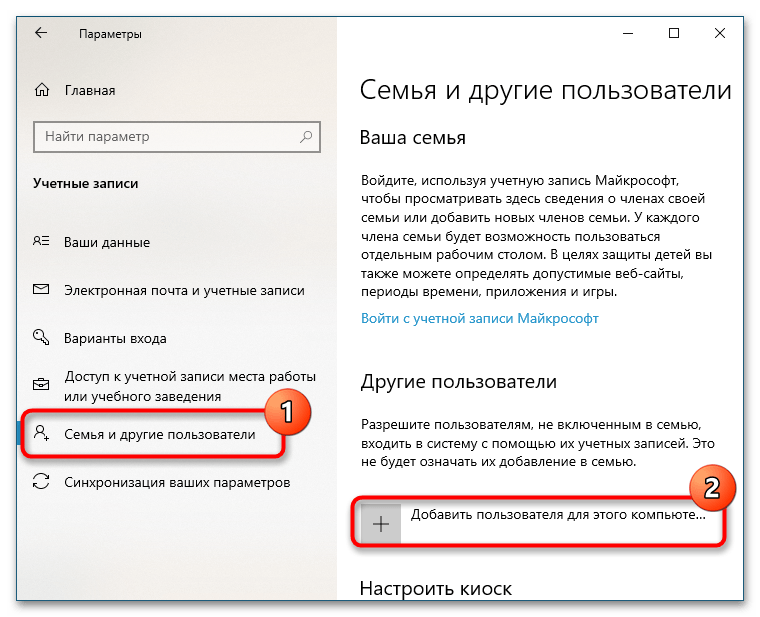
Но, как вариант, можно снять возможные правовые ограничения с папки, где находится исполняемый файл проблемного приложения, или даже с локального диска. Если ошибка появляется при попытке установить приоритет для системного процесса или службы, то, вероятно, происходят ошибки при взаимодействии со стандартными файлами. Устранить неполадку можно в несколько кликов:
- Независимо от того, локальный диск это или отдельная папка, щелкните по названию элемента правой кнопкой мыши и выберите пункт «Свойства» из контекстного меню.
- В появившемся окне перейдите на вкладку «Безопасность». Снимите выбор со всех учетных записей в поле «Группы или пользователи», щелкнув ЛКМ по свободной области, и нажмите на кнопку «Изменить».
- На следующем этапе кликните по кнопке «Добавить».
- В специальном поле для ввода имен объектов напишите «Все», затем щелкните по «Проверить имена».
- После того как проверка закончится, введенный запрос подчеркнется линией. Кликните по «ОК», чтобы сохранить изменения и выйти из этого окна.
- Вы вернетесь в окно с настройкой безопасности, где в списке «Группы или пользователи» появится новый пункт – «Все». Выделите его, затем ниже отметьте все пункты в столбце «Разрешить». Примените и сохраните настройки.
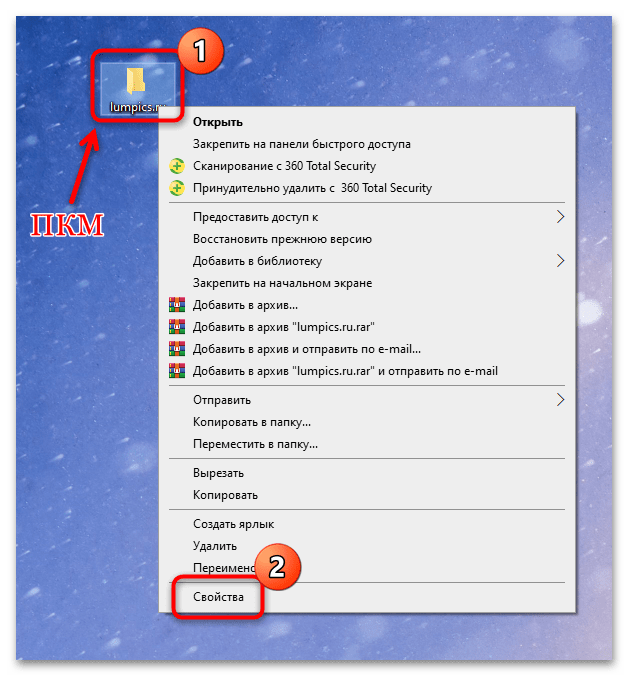
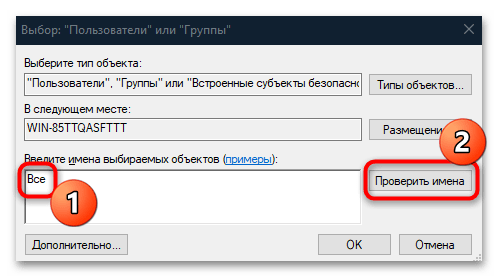
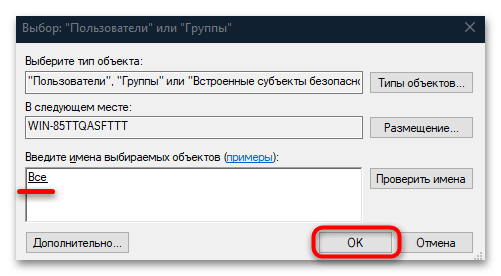
На внесение изменений потребуется время – дождитесь, пока устанавливается безопасность для созданного объекта. Перезагрузите систему, а потом попробуйте снова установить приоритет в «Диспетчере задач».
Способ 2: Отключение UAC
Функция UAC, или контроль учетных записей, обеспечивает защиту ПК от потенциальной опасности, которая может возникнуть после установки сторонних программ. Но помимо этого, настройки применяются и к учетным записям, как административным, так и пользовательским. Последние ограничены правами в доступе, и некоторые приложения не будут запускаться без полномочий администратора. Некоторые действия, вносящие изменения в работу ОС, также будут заблокированы.
При появлении рассматриваемой ошибки в «Диспетчере задач» можно отключить контроль учетных записей через «Панель управления» или редактирование реестра. О способах деактивации UAC в Windows 10 мы писали ранее.
Подробнее: Отключение UAC в Windows 10
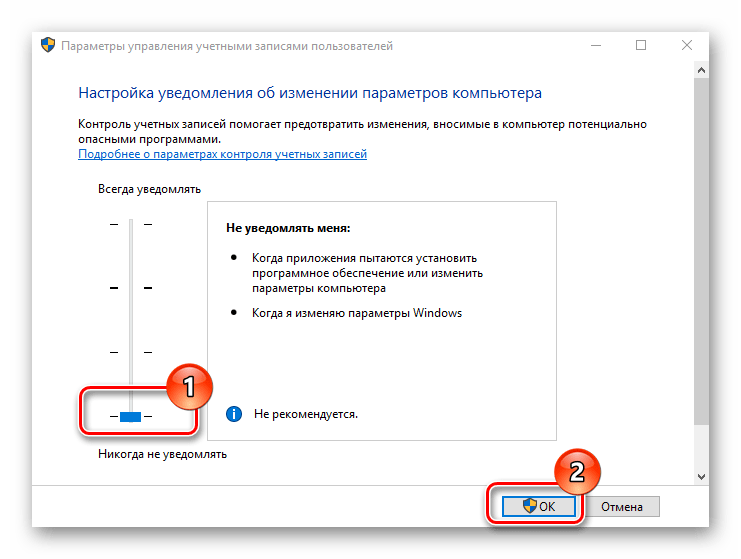
Способ 3: «Безопасный режим»
Вероятно, в работу системы вмешивается установленная программа, которая не позволяет выставить приоритет для определенных задач. Обычно такое происходит со сторонними процессами или службами. В этом случае можно попытаться запустить «десятку» в «Безопасном режиме», при котором отключаются все лишние процессы на ПК, а затем попробовать снова проделать необходимые действия в «Диспетчере устройств». Переходите по ссылке ниже, чтобы узнать, как использовать режим в Windows 10.
Подробнее: Безопасный режим в Windows 10
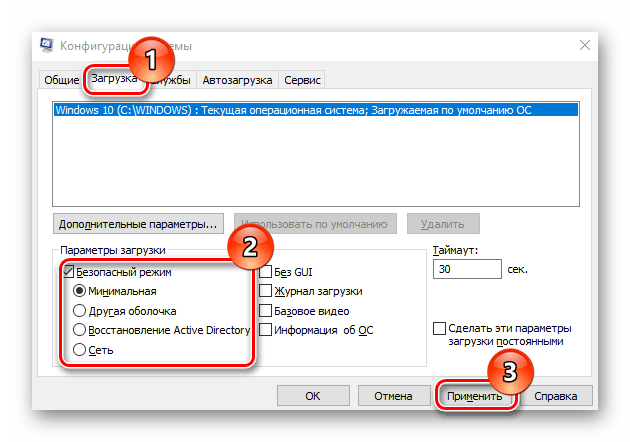
Если в «Безопасном режиме» ошибки не наблюдается, следует искать виновника среди запущенного программного обеспечения в обычном режиме.
Вариант 2: Завершение процесса
Иногда при попытке завершить тот или иной процесс в Windows 10 через «Диспетчер задач» также возникает неполадка с доступом. Для ее исправления тоже есть несколько рекомендаций, о которых речь пойдет ниже.
Следует отметить, что предыдущие способы из Варианта 1 также могут подойти для исправления неудачного завершения задач, особенно если для операции нет соответствующих прав администратора.
Способ 1: «Командная строка»
Первое, что следует попробовать в сложившейся ситуации, — завершить процесс с помощью встроенной консоли, называющейся «Командная строка». Для этого предусмотрено несколько команд:
- Вызовите меню «Пуск» или поисковую строку, где введите
cmd, затем в правой части окна выберите пункт «Запуск от имени администратора». - Напишите команду
tasklistи нажмите на клавишу «Enter», чтобы посмотреть все запущенные на ПК процессы. - Помимо названия программ и служб, отобразится еще несколько столбцов. В центральном – идентификатор процесса, или PID. Он может потребоваться для дальнейших команд. А крайний правый столбец говорит об объеме памяти, который использует софт. Проще всего для закрытия процесса использовать PID – цифровое значение. Выполните команду
taskkill, указав идентификатор задачи. Также можно использовать функцию принудительного завершения, используя параметр/F. В окне консоли команда будет выглядеть так:taskkill /PID 8484 /F, если мы решили закрыть процесс «browser.exe».
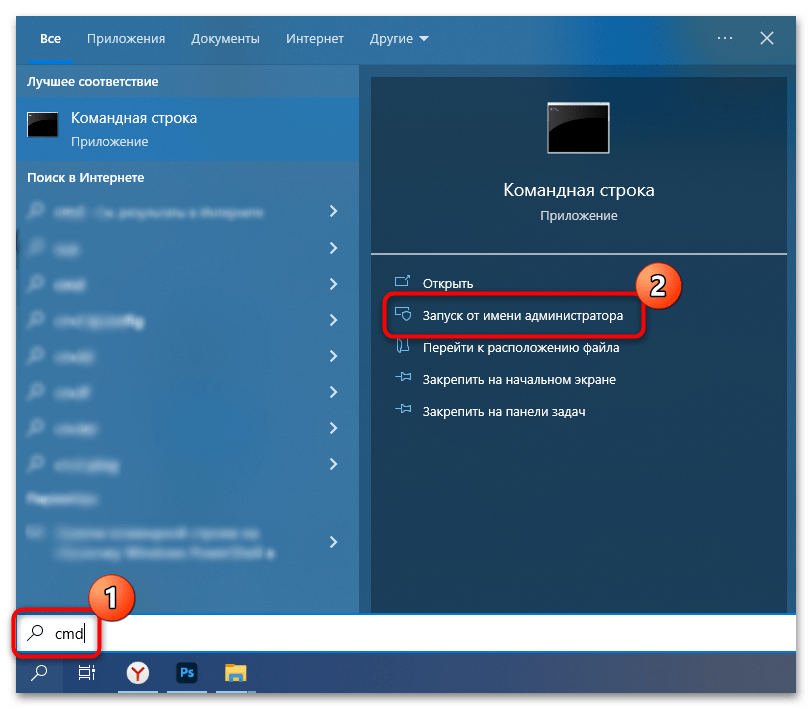
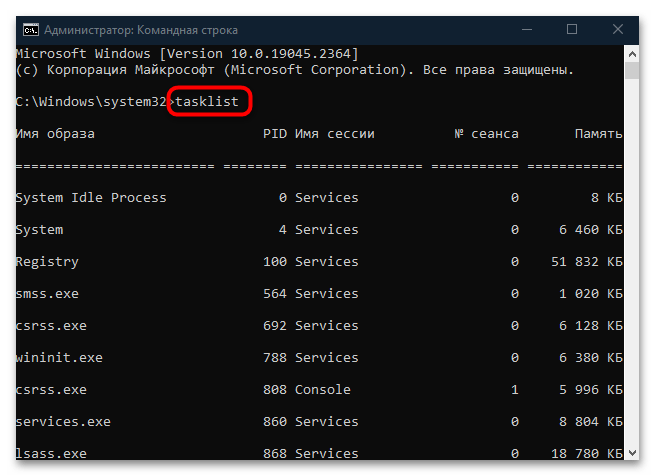
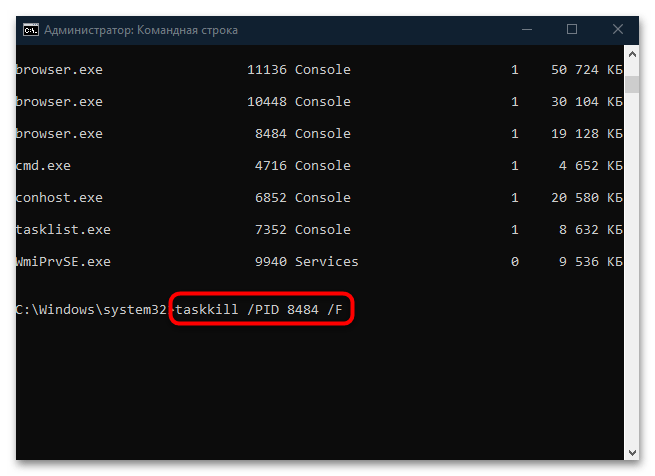
Кроме того, можно использовать параметр
/Mпри завершении процесса по названию –taskkill /M browser.exe /F.
Способ 2: Сторонние утилиты
Когда стандартный «Диспетчер задач» начинает работать с ошибками, в качестве временного решения выполнить операцию можно через сторонние утилиты, являющиеся альтернативой штатному средству. Большинство из них располагает такими же функциями, а у некоторых есть и расширенные настройки. На нашем сайте есть обзор таких приложений с кратким описанием и ссылками для скачивания. Переходите к статье, чтобы ознакомиться и выбрать наиболее подходящее средство.
Подробнее: Альтернативы «Диспетчера задач» для Windows 10
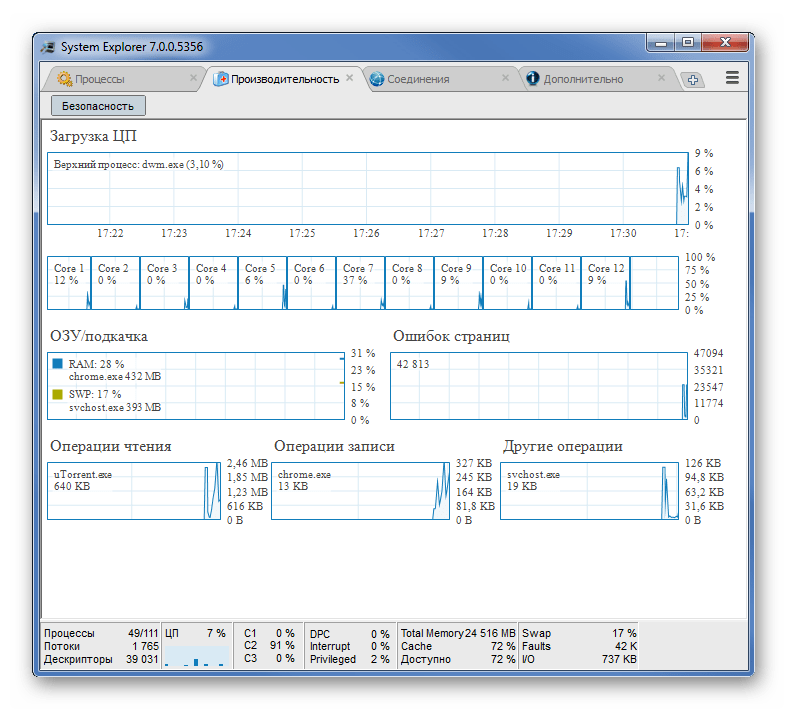
Дополнительно рекомендуем ознакомиться с материалом далее, где описаны рекомендации по восстановлению работоспособности встроенного приложения. Даже если у вас не наблюдается других ошибок, кроме как «Отказано в доступе», все равно воспользуйтесь инструкциями по ссылке ниже.
Подробнее: Восстановление работоспособности «Диспетчера задач» в Windows 10
Способ 3: Проверка на вирусы
Когда вредоносное ПО попадает в систему, оно может нарушать ее работу, препятствуя выполнению различных задач, с которыми раньше не возникало проблем. К сожалению, вирусы способны также ограничивать доступ к остановке служб и процессов, особенно через штатный «Диспетчер задач». Чтобы решить проблему, проверьте Windows 10 на наличие такого опасного софта, используя специализированные программы или встроенные возможности «десятки». Как это сделать, мы подробно разбирали в другом нашем руководстве.
Подробнее: Методы удаления вируса с компьютера под управлением Windows 10

Наша группа в TelegramПолезные советы и помощь
-
Home
-
News
- 5 Fixes to Unable to Terminate Process Access Is Denied
By Shirley | Follow |
Last Updated
Have you ever encountered the error message “unable to terminate process access is denied” when you try to kill a process in Task Manager? In this post from MiniTool, we will tell you what should you do if you cannot stop the process because of the access is denied error.
Error: Unable to Terminate Process Access Is Denied
Task Manager is a powerful system utility that can be used to terminate unwanted processes. However, it doesn’t always work as expected. For example, many users reported that they received an error message saying “unable to terminate process access is denied” when trying to end a process through Task Manager.
If you are unable to stop services due to this error message, you can get it resolved by applying the approaches below.
How to Fix Unable to Terminate Process Access Is Denied Windows 11/10
Fix 1. Use the Alt + F4 Keyboard Shortcut
If the End task button is not working in Task Manager, you can terminate an application by using the Alt + F4 keyboard shortcut.
Just stay on the page of the program that you want to stop running, then press the Alt + F4 key combination on your keyboard. This should kill the selected process.
Tips:
Occasionally, pressing the wrong keyboard key combination may result in data being deleted, such as files being deleted by Ctrl + Z. In such a situation, you can use MiniTool Power Data Recovery to recover deleted files. This free file recovery software is specialized in recovering documents, pictures, videos, audio, emails, etc.
MiniTool Power Data Recovery FreeClick to Download100%Clean & Safe
Fix 2. Run Task Manager as Administrator
The inability to end a task through Task Manager may be due to insufficient permissions for this program. Running Task Manager as administrator will guarantee that it has full permission to do whatever it needs to do on your computer.
First, in the Windows search box, type task and then right-click Task Manager from the best match result to select Run as administrator.
Second, select the unnecessary app or process and then click the End task button.
Fix 3. Terminate the Process With WMIC Command
Aside from Task Manager and the Alt + F4 key combination, you can kill a process with CMD. You can use Windows Management Instrumentation Console (WMIC) to complete this task. It supports such actions as configuring security settings, changing system settings, scheduling processes, etc.
Step 1. Open Command Prompt as administrator.
Step 2. Select the Yes option in the UAC window.
Step 3. In the command line window, type wmic process where name=’processname’ delete and press Enter.
Tips:
You need to replace the processname part with the actual process name. In Task Manager, right-click the target application and select Go to details. Then you can see the process name.

Fix 4. Kill the Process Using the Taskkill Command
Another command line for terminating processes is the taskkill command. Similar to WMIC, to use this command, you also need to know the detailed process name (Go to Task Manager > Details).
Step 1. Run Command Prompt as administrator.
Step 2. Type taskkill /im processname /f and press Enter. Remember to replace the process name with the actual one.
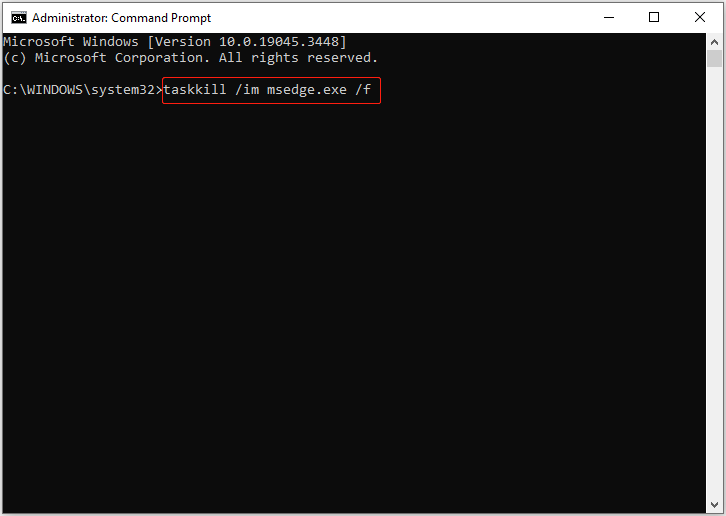
Fix 5. Scan the Computer for Virus
If you keep receiving the “unable to terminate process access is denied” error message, your computer may have been attacked by a virus. In this situation, you need to use antivirus software such as Windows Defender to find and kill the viruses.
For the detailed steps to scan for a virus, you can refer to this tutorial: How to Open and Use Windows Defender in Windows 11/10.
Wrapping Things Up
In a word, this article provides you with several alternative ways to stop unnecessary processes when receiving the “unable to terminate process access is denied” error.
If your files on the Windows computer are lost due to wrong operations or virus attacks, you can use MiniTool Power Data Recovery Free Edition to get lost files back.
MiniTool Power Data Recovery FreeClick to Download100%Clean & Safe
For further assistance, please contact [email protected].
About The Author
Position: Columnist
Shirley graduated from English major and is currently an editor of MiniTool Team. She likes browsing and writing IT-related articles, and is committed to becoming a professional IT problem solver. The topic of her articles are generally about data recovery, data backup, and computer disk management, as well as other IT issues. In spare time, she likes watching movies, hiking and fishing.
An unresponsive window or application is one of the most common issues Windows users face at least once. The ultimate way to handle it is to end the background process using the Task Manager. However, sometimes when you try to end a process, the End Process option is unavailable, and you get the “Unable to Terminate Process Access is Denied” error.
If you are also facing the said problem, let us look at the core reasons behind it and how to solve the inability to terminate process access denied error on Windows. To kick things off, let’s begin by addressing the issues that cause the error.
Reasons For “Unable to Terminate Process Access is Denied Error”
When running an application heavy on CPU resources, getting an unresponsive message is common. However, when you start to encounter it often, closing the application is the first thing you want to do, and this is when you turn to the Task Manager.
But suppose your PC is slow or unable to handle the tasks. In that case, its performance is affected, causing issues where even the Task Manager doesn’t load and shows Unable to terminate Process Access is Denied error. But why does this issue appears on your PC? There are several reasons responsible for it. Here we list the most common ones:
- Corrupt Windows files or registry issues.
- Malware on your PC.
- Interference caused due to third-party application.
- Issues with the log files.
- Faulty Windows update.
- Unresponsive game or an application that requires a lot of resources.
These errors indicate that you should optimize your PC for playing games before running a heavy application or game. This will make a lot of difference.
Also Read: You Must Enable System Protection on this Drive” in Windows
How to Resolve the Unable to Terminate Process Access is Denied in Windows?
Now, there are two things to take care of –
- Handle the unresponsive application and end the process.
- Resolve the issue so that it does not appear again.
The solutions to the first problem, the unresponsive application, are listed below. So, if you are facing the error, opt for the following, and you will be good to go.
Also Read: This App Is Preventing Windows From Shutting Down
Solution #1 – Kill the task using Taskkill.
You can use the taskkill command in your Command Prompt and eliminate applications you cannot shut using the Task Manager. To run it all, you have to do is
- Press Ctrl + R to bring up the run dialog box.
- In the Run, type cmd and press Ctrl + Shift + Enter. This will open Command Prompt with admin rights.

- In the Cmd window, input the command –taskkill /im process-name /f
Note : im process-name in the above command refers to the process you want to end. The process name can be found in the Task Manager. Simply replace the process name with the process you want to end and hit enter.

- The command will run and instantly kill the task at hand, justifying the command name, taskkill.
Also Read: Windows Cannot Open the Folder
Solution 2 – Use the Windows management instrumentation console ( WMIC) to end the task.
In this solution, again, we will run Command Prompt as administrator. You can use the above instruction to run an elevated Command Prompt.
Note : Once you run the below command, the selected process will be deleted entirely from the Task Manager. This means you will not get any app notifications.
Here’s how you can use WMIC to handle unresponsive tasks –
- Open the elevated Command Prompt.
- Enter the command –wmic process where name=’processname.exe’ delete.
Replace the processname.exe with the name of the application process you want to end.

- Run the command to end the process right away.
You’d need to rerun the application if it were a necessary process, as WMIC will delete all processes.
Also Read: System Thread Exception Not Handled Error On Windows 10
Solution 3 – Reboot Your PC
If nothing works, or the above two solutions seem complex, simply reboot your PC. A reboot is a solution that works for almost all problems you face. The only downside is losing all your opened files and progress on projects.
How can you reboot your PC if it is hung and unresponsive?
Hold the power button for 5-10 seconds in such situations, and it will automatically shut down without harming your disk drive. Press the power button again and initiate the boot process.
Use these solutions, and your problem with the unresponsive application will be solved immediately.
Now, let’s talk about things you can do to ensure the error never returns to your PC.
The first thing that you should take care of is the Windows files optimization. One of the core reasons behind such errors is the existence of corrupt Windows files.
Alongside this, if the error Unable to Terminate Process Access is denied, occurs while running games, poor performance, and cluttered resources can also be a reason behind the issue.
Two things that can ensure that such an error never occurs are –
- Optimize PC performance so that enough resources are available to handle the task. This will keep the applications from becoming unresponsive in the first place.
- Keep your PC free of malware, spyware, and corrupt files. This will help quickly end the process using the Task Manager when the time comes.
Now, how to implement both of these on your PC? There are multiple ways to do it. However, we will not get into the complex solutions as no one wants that. The abovementioned things can be taken care of with a single application called Advanced System Optimizer.
It is a one-of-a-kind optimization tool that can be the ultimate solution to assist you with the error. How? Well, check out how the tool works and what modules you get with it –
- Download the tool from the link below and run the application on your PC.
- Once you have opened the application, you can find various tools available for PC optimization.

- Simply navigate to the Registry Optimizers to initiate any fixes that your Windows or registry files may require.

- Click Registry Cleaner and run a scan to fix invalid registry entries.
- After this, head to the PC Optimizers module to ensure that your PC performance is well maintained.
- The best part is that with all these tools, you also have a comprehensive scanner available that evaluates your PC on all fronts to ensure that there are no discrepancies in the performance of your PC.

In simple words, the tool can help fix PC errors, corrupt registry files, and maintain a perfectly optimized performance-to-resources ratio. Using this tool will ensure that you never have to face the unable to terminate the process; access is denied in Windows.
Fixed – Unable To Terminate Process
The error Unable to Terminate Process, Access is denied is an uncommon issue and appears when your PC suffers from bugs and optimization issues. We hope the information covered in the blog gives you instant relief from your problem and a long-term resolution of the error, so it never happens again.
Let us know what worked best for you in the comments and whether downloading and using Advanced System Optimizer made the process easier. That’s all for this post!
Recommended :
Top Features to Look For in PC Optimizer Software
How to Fix Unidentified Network Error on Windows 11

Image Credit:
GaudiLab/iStock/GettyImages
If you’re unable to kill a process on your device, getting a message like «Unable to Terminate Process Access is Denied» or the equivalent, you may need to kill the process using another account, such as an administrator account. If that fails as well, you can try to reboot the machine as a last resort to stop the process.
End Process With Access Denied
If you’re on Microsoft Windows and getting an «access denied» error when trying to terminate a running application in the Windows Task Manager, you may still be able to kill the process using a different user account. If you’re not the user who started the process, you often don’t have the right to stop it.
If you’re using a multiuser machine, you may want to check to see who started the process and ask that person to end it. That way you can make sure that you’re not interfering with somebody else’s work when you end the process.
If you’re the only user on the machine, or you’re confident the process isn’t doing anything useful for anyone else, you can use an administrator account to end the process. To do so, you must have the administrator password on the computer. If you’re using a corporate machine, you may need to ask your IT department or the equivalent for help.
Using an Administrator Account
To use an administrator account to end the process, you can either log into the system using an account with administrator privileges or open the command line using an administrator password while staying logged in to another account.
To log in as an administrator, first log out from your normal account. In Windows 10 or Windows 8, do this by clicking the «Start Menu» and then clicking your username and choosing the «Sign Out» button. In older versions of Windows, click the «Shut Down» button within the «Start Menu» and then choose the «Log Out» option.
Once you’re logged out, log back in typing the username and password of an administrator account. Then, launch the Windows Task Manager by holding down the control and shift keys on your keyboard and hitting «Escape.» Kill the process in question by clicking it, then clicking «End Task.» Log back out and back into your normal account to continue working.
Using the Command Line
You can also end a task with access denied using the Windows command line with administrator privileges.
On Windows 10 or Windows 8, right-click on the bottom left corner of the screen and click «Command Prompt (Admin).» On Windows 7, click the «Start Menu» and type «cmd» in the search box. Right-click on the «Command Prompt» icon and click «Run as Administrator.»
Once you have the command line open, type «taskkill /IM «[process-name]» /T /F» and press enter, where «process-name» is the name of the process as listed in the Task Manager.
Other Operating Systems
You can run into similar issues on other operating systems, such as Linux and macOS.
In either of those operating systems, you can kill a process using the «kill» command from the command line. Open a command line window and type «kill [pid]» where «pid» is the process ID, which you can obtain using the «ps» or «top» commands.
If the kill command fails with access denied, run a «sudo kill [pid]» command. The «sudo» command will prompt you for your password and allow you to run the command as an administrator. If this doesn’t kill the process, you can try running «sudo kill -9 [pid]» – which should terminate the process immediately.
This problem occurs with users who try to terminate a process from the Task Manager. Once you select the process and click the End Task button, you will see an error message indicating that the operation could not be completed. Most users who encounter this issue experience problems running games or other applications. These users cannot run the applications either because they receive the error “Program is already open” or because they see multiple instances of the same app in the Task Manager. This issue is not specific to these cases, though; you might see this message while trying to terminate a hung app or an unwanted app. In all these cases, this Access Denied error will appear when you try to eliminate the process.
The reason behind this issue isn’t clear, but the most likely contenders are either a Windows (Windows Update) bug or corrupted application files. Windows updates are known to introduce weird bugs, so this might be caused by a Windows bug. In this scenario, there isn’t much that you can do. However, if the problem is specific to a third-party application, then the issue might be a corrupted file. These cases are usually resolved after a reinstall.
Method 1: Use Command Prompt
The easiest solution is to use the command prompt to terminate a process. There are certain commands that can be used to do the same thing, i.e., terminate a process. Here are the steps for stopping processes:
- Press the Windows key once.
- Type command prompt in the Start Search box.
- Right-click Command Prompt from the search results and select Run as administrator.
- Type taskkill /im process-name /f and press Enter. You can get the process name by right-clicking the process you want to kill (from the Task Manager) and selecting Details. This will open the Details tab with your process already selected. Simply look at the name of the process and type it in the process-name.

You can run this command for all types of processes and see if this works for you.
Method 2: Enter Safe Mode and Reinstall
If the problem occurs when you try to terminate a third-party application process, try to uninstall and reinstall the application to see if that resolves the issue.
Here are the steps for getting into Safe Mode and then reinstalling the application:
Note: Make sure you have the application installer downloaded on the system before getting into Safe Mode.
- Hold the Windows key and press R.
- Type msconfig and press Enter.
- Select the Boot tab.

- Check the option Safe Boot in the Boot options section.
- Select the option Minimal under the Safe Boot option.
- Click Ok.

- Windows will ask you to restart. Click Restart.
- Once the system restarts, you will be in Safe Mode. Uninstall the problematic application. Hold the Windows key and press R.
- Type appwiz.cpl and press Enter.
- Locate the application and select it.
- Click Uninstall and follow the on-screen instructions.
- Now, reinstall the application by running its installer.
- Once the application is installed, you need to turn off the Safe Mode option.
- Hold the Windows key and press R.
- Type msconfig and press Enter.
- Select the Boot tab.

- Uncheck the option Safe Boot in the Boot options section.
- Click Ok.

- Windows will ask you to restart. Click Restart.
Your computer should start in normal mode. Check if the problem is resolved or not.
Method 3: Use Process Hacker
Process Hacker is a free tool designed to monitor system resources, debug software, and detect malware. However, we are only concerned with its ability to monitor the running applications. Process Hacker is considered an alternative to Task Manager and Process Explorer. This means that it can terminate processes just like Task Manager.
Using Process Hacker to terminate processes has worked for many users. Here are the steps for downloading and using Process Hacker to stop a process:
- Click here and click the Installer button to download Process Hacker.
- Once downloaded, install Process Hacker and run it.
- Process Hacker will show you a list of running applications. Simply right-click the problematic application and select Terminate.
- Click Terminate to confirm.
Repeat these steps for all the applications you want to terminate (the ones that Task Manager couldn’t). If Process Hacker can’t terminate the processes, there isn’t much you can do.
Method 4: Use Process Explorer
Process Explorer is another free tool that can be used to explore the processes running on your system. This tool gives a detailed view and allows the editing of permissions as well. If Process Hacker didn’t work, you might try Process Explorer to see if this helps you terminate the application. Follow the steps below:
- Click here and select the link Download Process Explorer. This will download a zip file for you.
- You will need a compression program to unzip the contents of the downloaded file. Use Winzip or WinRAR.
- Double-click the downloaded zip file.
- Double-click procexp.exe or procexp64.exe to open Process Explorer.
- Once Process Explorer starts, it will give you a detailed list of programs running on your system. Locate and double-click the problematic application.
- Click the Security Tab.
- Click Permissions.

- Click Advanced.
- Select your account from the list.
- Click Edit.

- Check the options Full Control, Read, and Write.
- Click Show advanced permissions.

- Make sure the option Terminate is checked.
- Click Ok and click Ok again.

- Click Ok for all other Windows.
- Now, when you are back at Process Explorer, right-click the problematic program and select Kill Process.
This should solve the issue. If you are still having issues, do the following:
- Click on the File option (from Process Explorer) and select Show Details for All Processes.
- Click Yes if it asks for permissions.
- Process Explorer will restart now. Once Process Explorer restarts, right-click the problematic application and select Kill Process. This should solve the issue.
Method 5: Use WMIC
WMIC stands for Windows Management Instrumentation Console. This utility can be used to terminate processes as well. You can use WMIC and its commands to terminate processes from the command prompt. Some users found this helpful in getting rid of the problematic application. Here are the steps for using WMIC commands:
- Press the Windows key once.
- Type command prompt in the Start Search box.
- Right-click Command Prompt from the search results and select Run as administrator.
- Type wmic process where name=’myprocessname.exe’ delete and press Enter. You can get the process name by right-clicking the process you want to kill (from the Task Manager) and selecting Details. This will open the Details tab with your process already selected. Simply look at the name of the process and type it in the myprocessname.exe (don’t remove the quotes).

This should resolve the issue for you.
Method 6: Reboot
If nothing else worked, then this is your only choice. There are some processes that cannot be terminated, especially if you are dealing with system processes. This isn’t a solution, but it’s an option you are left with. A simple reboot will usually resolve the issue, and you will be able to use the application normally once the restart is complete.
Kevin Arrows
Kevin Arrows is a highly experienced and knowledgeable technology specialist with over a decade of industry experience. He holds a Microsoft Certified Technology Specialist (MCTS) certification and has a deep passion for staying up-to-date on the latest tech developments. Kevin has written extensively on a wide range of tech-related topics, showcasing his expertise and knowledge in areas such as software development, cybersecurity, and cloud computing. His contributions to the tech field have been widely recognized and respected by his peers, and he is highly regarded for his ability to explain complex technical concepts in a clear and concise manner.
